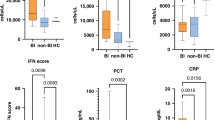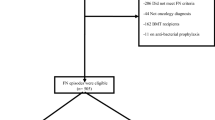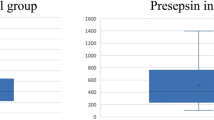Abstract
Background
Poor and delayed microbiological documentation of episodes of febrile neutropenia (EFN) deserves improvement. We assessed the impact of a new blood culture (BC) sampling protocol to optimize the diagnosis of bloodstream infection during EFN, compared with standard of care protocol.
Methods
This pre/post intervention included patients who presented an EFN in a pediatric hematology-oncology center. Data were compared between 1-year periods P1 (110 EFN, 53 patients) and P2 (124 EFN, 53 patients). Pre-intervention settings were 1−2 mL of blood cultured per BC set and several samplings over days (multisampling strategy) during period P1 vs. one unique early sampling of a large volume of blood (0.5–60 mL) depending on patient weight during period P2 (single-sampling weight-adapted strategy). Microbial detection and time-to-diagnosis were evaluated.
Results
Seventeen EFNs were microbiologically documented in P1 (15.5%) and 26 in P2 (21%). The rate of positive BC sets increased during P2 (10.4% vs. 5.8%). All cases of bacteremia were documented by BC drawn during the first 4 days of fever, and during P2 by samples obtained on the first day of fever.
Conclusions
Bacteremia detection was improved. This proof-of-concept study shows benefits of combining the single-sampling strategy with large weight-adapted blood sampling strategy during EFN.
Impact
-
Combination of single-sampling and weight-adapted blood culture strategies showed benefits in the documentation of bloodstream infections during febrile neutropenia.
-
Bacteremia detection was improved in this preliminary study and this warrants further evaluation in the overall pediatric population.
-
We observed no adverse effects associated with the new strategy while overall blood sparing was improved and handling of intravascular devices was reduced.
-
The good tolerance of the blood sampling suggests that the recommended 1% volume limitation in children could be reconsidered.
-
A similar evaluation is justified in the overall pediatric population suspected for bloodstream infection.
Similar content being viewed by others
Log in or create a free account to read this content
Gain free access to this article, as well as selected content from this journal and more on nature.com
or
References
Ardura, M. I. & Koh, A. Y. in Principles and Practice of Pediatric Oncology 7th Edition (eds Pizzo, P. & Poplack, D.) 1010−1057 (Lippincott Williams & Wilkins, Riverwoods, 2015).
Hakim, H., Flynn, P. M., Knapp, K. M., Srivastava, D. K. & Gaur, A. H. Etiology and clinical course of febrile neutropenia in children with cancer. J. Pediatr. Hematol. Oncol. 3, 623–629 (2009).
Castagnola, E. et al. A prospective study on the epidemiology of febrile episodes during chemotherapy-induced neutropenia in children with cancer or after hemopoietic stem cell transplantation. Clin. Infect. Dis. 45, 1296–1304 (2007).
Meckler, G. & Lindemulder, S. Fever and neutropenia in pediatric patients with cancer. Emerg. Med. Clin. North Am. 27, 525–544 (2009).
Isaacman, D. J., Karasic, R. B., Reynolds, E. A. & Kost, S. I. Effect of number of blood cultures and volume of blood on detection of bacteremia in children. J. Pediatr. 128, 190–195 (1996).
Kellogg, J. A., Manzella, J. P. & Bankert, D. A. Frequency of low-level bacteremia in children from birth to fifteen years of age. J. Clin. Microbiol. 38, 2181–2185 (2000).
Lamy, B., Dargère, S., Arendrup, M. C., Parienti, J. J. & Tattevin, P. How to optimize the use of blood cultures for the diagnosis of bloodstream infections? A state-of-the art. Front. Microbiol. 7, 697 (2016).
Huber, S., Hetzer, B., Crazzolara, R. & Orth-Höller, D. The correct blood volume for paediatric blood cultures: a conundrum? Clin. Microbiol. Infect. 26, 168–173 (2020).
Cuenca-Estrella et al. ESCMID guideline for the diagnosis and management of Candida diseases 2012: diagnostic procedures. Clin. Microbiol. Infect. 18(Suppl 7), 9–18 (2012).
Lamy, B. & Seifert, H. in European Manual of Clinical Microbiology (SFM/ESCMID) 1st edn (eds Courcol, R. et al.) 15−20 (SFM, Paris, 2012).
Baron, E. J. et al. A guide to utilization of the microbiology laboratory for diagnosis of infectious diseases: 2013 recommendations by the Infectious Diseases Society of America (IDSA) and the American Society for Microbiology (ASM). Clin. Infect. Dis. 57, e22–e121 (2013).
Lamy, B., Roy, P., Carret, G., Flandrois, J. P. & Delignette-Muller, M. L. What is the relevance of obtaining multiple blood samples for culture? A comprehensive model to optimize the strategy for diagnosing bacteremia. Clin. Infect. Dis. 35, 842–850 (2002).
Lamy, B., Sundqvist, M. & Idelevich, E. A. Bloodstream infections—standard and progress in pathogen diagnostics. Clin. Microbiol. Infect. 26, 142–150 (2020).
Lehrnbecher, T. et al. Guideline for the management of fever and neutropenia in children with cancer and/or undergoing hematopoietic stem-cell transplantation. J. Clin. Oncol. 30, 4427–4438 (2012).
Hentrich, M. et al. Central venous catheter-related infections in hematology and oncology: 2012 updated guidelines on diagnosis, management and prevention by the Infectious Diseases Working Party of the German Society of Hematology and Medical Oncology. Ann. Oncol. 25, 936–947 (2014).
Barton, C. D., Waugh, L. K., Nielsen, M. J. & Paulus, S. Febrile neutropenia in children treated for malignancy. J. Infect. 71(Suppl 1), S27–S35 (2015).
Averbuch, D. et al. Antimicrobial resistance in Gram-negative rods causing bacteremia in hematopoietic stem cell transplant recipients: intercontinental prospective study of the Infectious Diseases Working Party of the European Bone Marrow Transplantation group. Clin. Infect. Dis. 65, 1819–1828 (2017).
Kaditis, A. G., O’Marcaigh, A. S., Rhodes, K. H., Weaver, A. L. & Henry, N. K. Yield of positive blood cultures in pediatric oncology patients by a new method of blood culture collection. Pediatr. Infect. Dis. J. 15, 615–620 (1996).
Dien Bard, J. & Tekippe, E. M. Diagnosis of bloodstream infection in children. J. Clin. Microbiol. 54, 1418–1424 (2016).
Gaur, A. et al. Optimizing blood culture practices in pediatric immunocompromised patients: evaluation of media types and blood culture volume. Pediatr. Infect. J. 22, 545–552 (2003).
Szymczak, E. G., Barr, J. T., Durbin, W. A. & Goldmann, D. A. Evaluation of blood culture procedures in a pediatric hospital. J. Clin. Microbiol. 9, 88–92 (1979).
Freifeld, A. G. et al. Clinical practice guideline for the use of antimicrobial agents in neutropenic patients with cancer: 2010 update by the Infectious Diseases Society of America. Clin. Infect. Dis. 52, e56–e93 (2011).
Arendrup, M., Jensen, I. P. & Justesen, T. Diagnosing bacteremia at a Danish hospital using one early large blood volume for culture. Scand. J. Infect. Dis. 28, 609–614 (1996).
Li, J., Plorde, J. J. & Carlson, L. G. Effects of volume and periodicity on blood cultures. J. Clin. Microbiol. 32, 2829–2831 (1994).
Leyssene, D. et al. Species-driven interpretation guidelines in case of a single-sampling strategy for blood culture. Eur. J. Clin. Microbiol. Infect. Dis. 30, 1537–1541 (2011).
Rosenblum, J., Lin, J., Kim, M. & Levy, A. S. Repeating blood cultures in neutropenic children with persistent fevers when the initial blood culture is negative. Pediatr. Blood Cancer 60, 923–927 (2013).
Wattier, R. L., Dvorak, C. C., Auerbach, A. D. & Weintrub, P. S. Repeat blood cultures in children with persistent fever and neutropenia: diagnostic and clinical implications. Pediatr. Blood Cancer 62, 1421–1426 (2015).
Petty, L. A. et al. Repeated blood cultures in pediatric febrile neutropenia: would following the guidelines alter the outcome? Pediatr. Blood Cancer 63, 1244–1249 (2016).
Acknowledgements
This work was supported by the University Hospital of Montpellier.
Author information
Authors and Affiliations
Contributions
B.L., H.M. and N.S. conceptualized and designed the study, carried out the analyses, and drafted reviewed and revised the manuscript. S.D. collected the data, carried out the analyses, drafted the initial manuscript, and critically reviewed the manuscript. L.S. and S.H. conceptualized and designed the study, collected the data, and reviewed and revised the manuscript. All authors approved the final manuscript as submitted and agree to be accountable for all aspects of the work.
Corresponding author
Ethics declarations
Competing interests
The authors declare no competing interests.
Informed consent
This study is an observational study that fell within routine practice with nonadditional diagnostic and monitoring procedures applied to the patient. During period 1 data derived from routine clinical care were retrospectively analyzed. During period 2, the unit switched its blood culture sampling strategy; data were prospectively collected but strictly corresponded to the routine care of the patients with no additional intervention. Thus, research concerns only data derived from the routine care of the patient. In this context, the Ethics Advisory Committee waived the requirement to obtain a signed informed consent document, as accepted for research procedures involving no risk for the patient.
Additional information
Publisher’s note Springer Nature remains neutral with regard to jurisdictional claims in published maps and institutional affiliations.
Rights and permissions
About this article
Cite this article
Lamy, B., Dutron, S., Haouy, S. et al. Optimized blood culture strategy to document febrile neutropenia. Pediatr Res 89, 1109–1116 (2021). https://doi.org/10.1038/s41390-020-1086-0
Received:
Revised:
Accepted:
Published:
Issue date:
DOI: https://doi.org/10.1038/s41390-020-1086-0
This article is cited by
-
S3-Leitlinie Sepsis – Prävention, Diagnose, Therapie und Nachsorge – Update 2025
Medizinische Klinik - Intensivmedizin und Notfallmedizin (2025)



